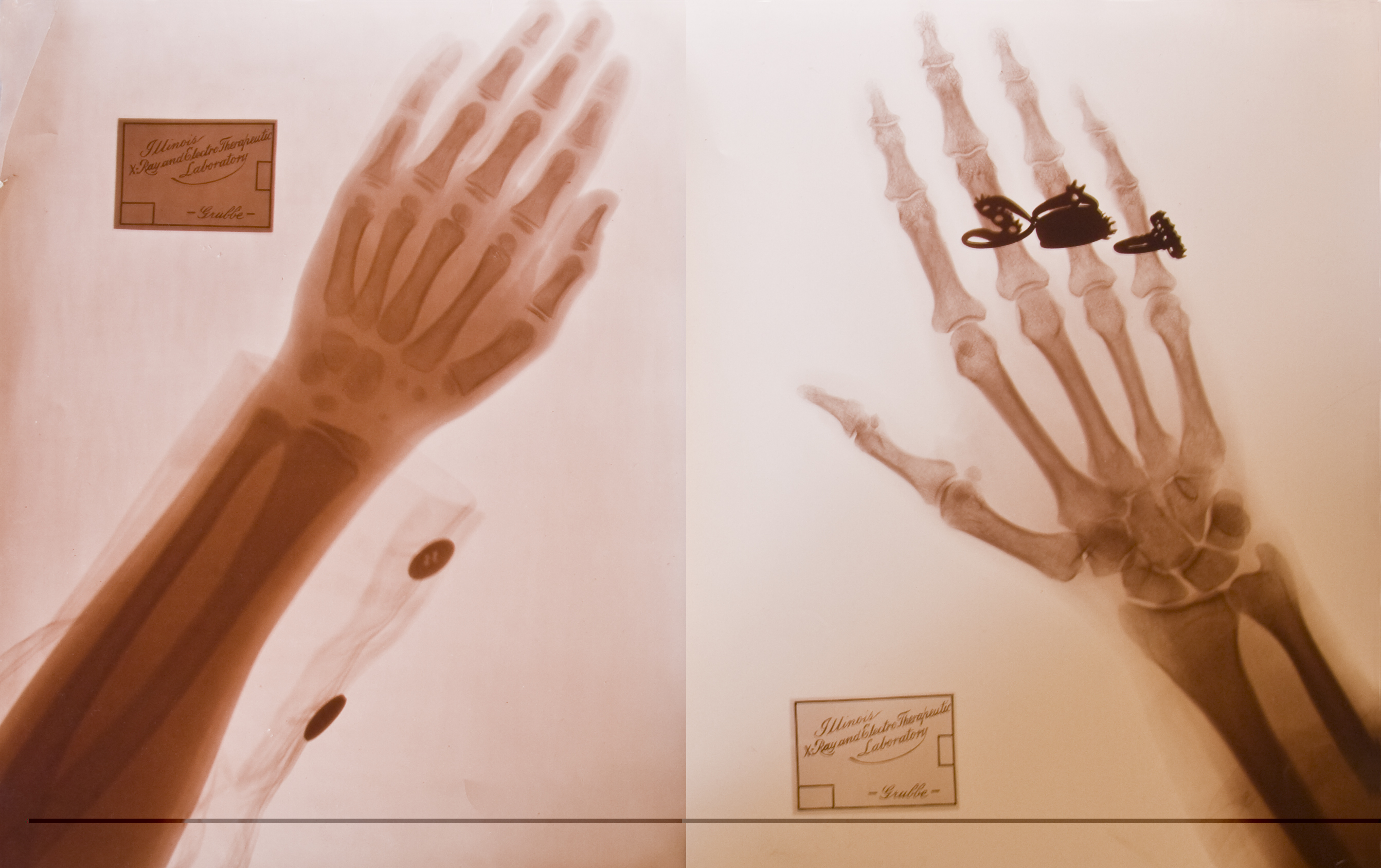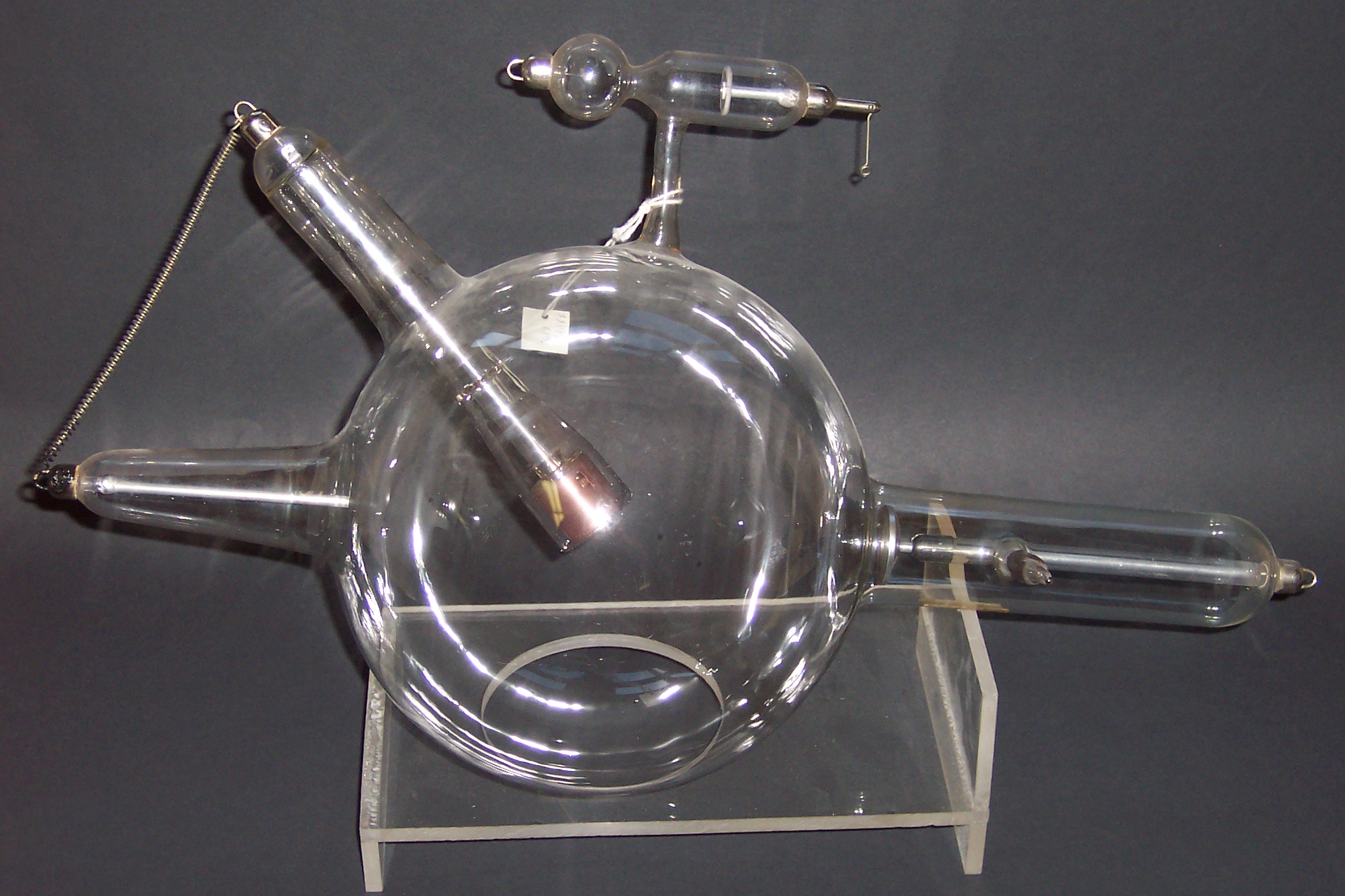Published by Emily Baughman
Beauty is pain. Whether you’ve scored a nasty cut while shaving or destroyed your feet breaking in a pair of heels, everyone has flirted with danger in the name of becoming “more beautiful”. Dangerous beauty trends have come and, more importantly, gone throughout the years. From fad diets to bizarre make-up choices, few trends were as dangerous as x-ray treatments. Before we knew about the dangerous side effects, x-rays were an enormous fad, hailed as a solution for everything, including removal of unwanted hair. Especially for women, x-ray use in the name of beauty led to a grim conclusion. Gruesome side effects stuck around for much longer than the trend.

Original x-ray prints taken by Emil Grubbe, Chicago IL, c.1901. Collections of the International Museum of Surgical Science.
The discovery of x-rays shook the scientific community, but no one could have foreseen what it would do to the budding beauty industry. In 1895, Wilhelm Conrad Röntgen accidentally discovered x-rays while studying light in Germany (Chodos & Ouellette 2001). This discovery forever changed our understanding of light, and x-ray radiation research emerged as the new wild west. It didn’t take long for medicine to crave a piece of the x-ray pie. Medical researchers looked into using these electromagnetic waves for everything from diagnostic techniques to cures (Collins 2007). Only a year after the discovery, Leopold Freund began his research on x-rays and hair (Collins 2007). His work attempted to use x-rays to treat hypertrichosis, a skin disorder that causes excessive hair growth (Collins 2007). Freund discovered that when an area was treated with x-rays, the hair would eventually fall out. Hair removal was becoming not only important for these patients but for society at large as the 1900s rolled in.

Muller cold-cathode x-ray tube, with self-regulator and copper-clad anticathode, c. 1901-1910. Collections of the International Museum of Surgical Science.
As hemlines began to rise in the United States, razor companies started marketing their products towards women. Strappy dresses left shoulders and armpits exposed and clever advertising led to women shaving regularly for the first time in modern America (Women’s Museum of California 2017). Women have shaved their bodies on and off throughout history since ancient Egypt, but this was the beginning of it coming into fashion in the modern US (Women’s Museum of California 2017). During both World Wars, leg shaving grew sharply in popularity due to a push to save nylon for the war effort (Women’s Museum of California 2017). Women would shave to get the same smooth look of nylon stockings, while still being able to show they had bare legs as a sign of patriotism.
As many shavers would agree, hair removal isn’t a sprint but a marathon. Shaving is time-consuming, tedious, and rushing through the process can lead to a bloody conclusion. Plus, the results rarely stay for long. Some men shave in the morning only to have a 5 o’clock shadow by lunch. And many women know the pain of shaving just to have a slight breeze bring every prickly hair back. As the annoyances that came along with shaving added up, many knew there had to be a more permanent solution to hair removal. X-rays were the key. While it’s odd to think of today, x-rays became a fad after their discovery. They were hugely popular and were used for everything from shoe fitting to artistic photography. After the discovery that x-ray exposure could lead to hair loss, the treatment was marketed as an easy and long-term solution to shaving (Cleveland 1948). Largely marketed towards women, the beauty treatment took off. It was praised as a modern solution to the “ancient” problem of female body hair that had been plaguing the western public for a few decades. While the gift of hindsight makes us all cringe at this dangerous idea, x-ray hair removal was hugely popular and women poured into salons and doctors’ offices requesting to be parted from their unsightly hair (Cleveland 1948).

An advertisement for Tricho Hair Removal System. The woman in the ad’s drawing is holding her face up to a large x-ray machine to remove her facial hair. From Collins, Paul. “Histories: The Perils of X-Ray Hair Removal.” New Scientist, 5 Sept. 2007, www.newscientist.com/article/mg19526202-100-histories-the-perils-of-x-ray-hair-removal/.
After the dangers of long term exposure to radiation came to light, x-ray hair removal was officially taken off the market in 1946 (Herzig 1999). However, the ban didn’t stop some women from visiting back alley salons to get these dangerous treatments (Herzig 1999). A year later, the Journal of the American Medical Association published a study that described in horrific detail the cancers caused by radiation treatments (Herzig 1999). But that still didn’t stop some users. While most women understood the dangers of these potentially lethal x-rays, some continued to get treatments for years after until the practice finally fell out of fashion. The effects of radiation stayed around for longer than the fad. Cancer research in the 1970s uncovered that 35% of radiation-based cancers in women were connected to x-ray hair removal (Herzig 1999). While these patients were willing participants in controversial methods, they were also victims of a societal beauty standard that pushed them to such dangerous lengths.
Everyone feels the pressure of impossible beauty standards, whether you shave or not. While women face pressure to be hairless, men face the opposite problem. Many men are shamed for losing hair or for not being able to grow any to begin with. We’re all pressured to be something we are not. What people do or don’t do with their hair has shifted throughout the decades, similar to fashion. While there still is pressure being put on people, self-expression seems to be one of the biggest beauty trends out there. Hopefully, these trends of healthy self-acceptance stick around much longer than any of the toxic trends of the past.
Works Cited:
Cleveland, D E H. “The removal of superfluous hair by X-rays.” Canadian Medical Association Journal vol. 59,4 (1948): 374-7.
Collins, Paul. “Histories: The Perils of X-Ray Hair Removal.” New Scientist, 5 Sept. 2007, www.newscientist.com/article/mg19526202-100-histories-the-perils-of-x-ray-hair-removal/.
Herzig, Rebecca. “Removing Roots: ‘North American Hiroshima Maidens’ and the X Ray.” Technology and Culture, vol. 40, no. 4, 1999, pp. 723–745. JSTOR, www.jstor.org/stable/25147409.
“November 8, 1895: Roentgen’s Discovery of X-Rays.” Edited by Alan Chodos and Jennifer Ouellette, APS News, American Physical Society, Nov. 2001, www.aps.org/publications/apsnews/200111/history.cfm.
Women’s Museum of California. “The History of Female Hair Removal.” Women’s Museum of California, 22 Nov. 2017, womensmuseum.wordpress.com/2017/11/22/the-history-of-female-hair-removal/.
Emily Baughman is the current Spring 2020 Education Intern at the International Museum of Surgical Science. She is in her senior year finishing a biology major at Elmhurst College. She enjoys creating artwork inspired by her love of science and medicine.


